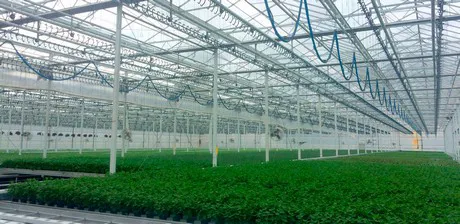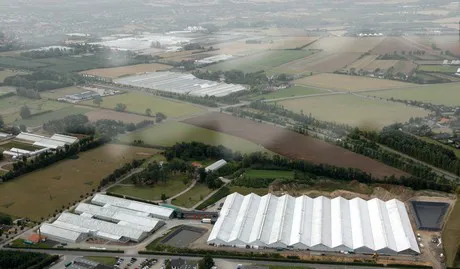With the upcoming legalization in Canada, marijuana producers have flocked to the country. But California has already had its 'green gold rush': ahead of the legalization of recreational cannabis in January, the California Association of Flower Growers & Shippers published a report on the state's potential for cannabis production.
"The potential expansion of legal cannabis production in greenhouses in the Central and South Coast regions of California may compete for resources with the cut flower industry, especially greenhouse space and farm labor", the researchers concluded. "We calculate that if 700,000 pounds of legal cannabis were grown in greenhouses, that would use between 2.5 percent and 8.2 percent of the greenhouse space used in the relevant industries."
Grupo Flor
Long before the report was published, California flower growers already realized the potential of growing marijuana. In 2016, Salinas Valley entrepreneurs founded Grupo Flor for the community to become a dominant California cannabis business ecosystem. The founders use their expertise in commercial real estate, cannabis laws, ag technology and relationship building to help shape California’s emerging cannabis market.
And in June 2017, local officials in Monterey County came up with a “land use” development decision related to encouraging cannabis investors to buy and make improvements on existing facilities first, before they would permit new construction. Therefore, old, dilapidated greenhouses that hadn’t been being used or had gone into disrepair would be the first to be used, as a former flower grower explains in this NPR article.
According to Grupo Flor, the group helped entrepreneurs lease over 2,600,000 square feet of properties in cannabis permitted zones throughout Monterey County. But it's not just California where ornamental growers have answered to the call of cannabis.
A different animal
Andy Easton of New Horizon Orchids has seen a major shift to cannabis cultivation in greenhouses, especially in the Salinas area. "Properties have changed hands for silly sums and now it seems reality is rearing its head. Many of the operations are partially set up by former bootleg growers from N. California. Now that the crop has to meet strict food crop standards for harvesting, they are finding difficulty in complying. In fact, local gossip is that many of the old crowd are actually going to continue with their old style illegal operations just as they did formerly because they do not wish to pay licensing charges or Federal Income Tax."
Andy says he's amazed too that some businesses seem to feel they are somehow immune to the old and proven law of supply and demand. "Prices for cannabis have already plummeted in California and one has to wonder where they will be by this coming September. Some of the people masquerading as 'growers' have minimal knowledge of basic horticultural practice or pest/disease control. When the most popular miticide is some concoction based on liquid dish soap and vinegar, I have to shake my head."
He sees bigger players taking over the cannabis cultivation market in California: "Cannabis-derived medicinal products are a different animal as far as I can see. But that enterprise will likely attract serious pharmaceutical companies who are used to operating under strict quality standards. As I see it, this is where cannabis and professional horticulture will coalesce in the foreseeable future."
On the other hand, Andy isn't optimistic about the viability of smaller operations: "A few months ago I met a young Dutch man who was in California scouting a greenhouse property to grow Phalaenopsis orchids. I smiled and then he told me he was not looking to buy now but he planned to be back in a couple of years when some of the current operators have gone to the wall. He thoughtfully commented that he felt he might buy a completely refurbished greenhouse for maybe 30 cents on the dollar from an upcoming fire sale. Smart fellow!"
Asked about the current situation, Kasey Cronquist, CEO of the California Cut Flower Commission, comments: "We are seeing flower farms in California take advantage of the rush towards cannabis production by increasing their cut flower production to meet the increasing demand left by farms who have left the cut flower business or diversified their production to include cannabis." Some of those examples can be found on the CCFC website. It's not just California where hemp is hip and happening though.
Future Farm Technologies / White Sands Nursery: 430,000 sq.ft. (Florida, US)
In May 2017, Future Farm announced the purchase of a 10-acre potted plant nursery near Orlando. According to the Orlando Sentinel, the purchase of the property in question, White Sands Nursery, was finalized in March 2018.

“This is a major step forward for Future Farm and positions us for tremendous growth for years to come,” said William Gildea, CEO and Chairman. “With this acquisition, Future Farm is potentially positioned as one of the public sector’s first movers into Florida’s cannabis market. This acquisition is in the designated legal grow zone with close proximity to Orlando, which has a local population of almost 2.5 million and attracts over 62 million visitors annually, making it a prime location.”
The company plans to upgrade the nursery’s technology platform with new computers and software, a new phone system and fully implemented automated accounting, inventory management and order tracking systems. In addition, the company plans to activate the online ordering platform, which to date has been non-functional, to penetrate higher margin markets such as direct to consumer wedding sales. Finally, the company plans to initiate an online and social media marketing effort in part by employing the services of an ad agency.
Puration / First Choice Nursery: 400 greenhouses (Texas, US)
In June 2017, Puration announced it had entered into a letter of intent agreement to acquire First Choice Nursery, with an existing twenty-five greenhouse facility in Texas.
The projected $1 million in annual revenue from the operation of 25 greenhouses would come primarily from the sale of traditional greenhouse grown flowers for use in residential landscaping. The original nursery operation had a long history that includes contracts with Lowes and Home Depot.
Puration and NCM Biotech planned to expand existing University Research relationships to include a portion of the greenhouse facility being utilized to develop a proprietary strain of CBD. Puration would use proceeds from the balance of the traditional nursery operation to expand the operation into its full 400 greenhouse potential.
Canopy Growth / Garden City Growers: 458,000 sq.ft. (Ontario, Canada)
In September 2017, Tweed Farms, wholly owned subsidiary of Canopy Growth Corporation and operator of the largest known licensed cannabis production facility in the world, finalized the purchase of a parcel of land adjacent to its current facility in Niagara-on-the-Lake, Ontario, including the operational 458,000 sq. ft. greenhouse of potted plant grower Garden City Growers.
The retrofit, set to commence in October 2017, would include: new irrigation systems, environmental controls, automation, and shading systems, all designed to maximize yields in an environmentally friendly way while meeting the Tweed standard for indoor and greenhouse growing.
Canopy Growth / Naeldebakken: 430,000 sq.ft. (Odense, Denmark)
In December 2017, Danish nursery Naeldebakken was declared bankrupt. The legalization of cannabis cultivation for medical purposes in Denmark, scheduled for the 1st of January 2018, made the circumstances ideal for Spectrum Cannabis, a Canopy Growth subsidiary, to purchase the 40,000 m2 greenhouse.

Chairman and CEO Bruce Linton mentioned: "In Denmark, we see a strong pharmaceutical industry with an equally strong research tradition as well as a skilled labour pool and attractive energy rates. Based on these foundational aspects and with the expertise of our partners at Danish Cannabis, I am confident we will build upon our global success here in Denmark."
"The greenhouses are completely empty at the moment, the floors and benches, everything is pulled out to create a state-of-the-art greenhouse that is suitable for medicinal cannabis production", said Bent Hansen, former Sales Manager at Naeldebakken, who would also be working for Spectrum Cannabis Denmark, just like some of his former colleagues: the company is expected to employ over 100 staff, including some former growers who will be offered employment with the company.
Colombia
Another interesting example is Colombia. The Latin American country has developed into a powerhouse of flower production, shaking off its reputation in regards to coca production. But some flower growers there are now also switching to the new cash crop.
One company that has taken advantage of the low-cost skilled flower farmers in Colombia is PharmaCielo. Shortly after the company was founded in 2014, it already started lobbying the country's government to legalize marijuana, which happened in 2015, as the Financial Post reported.
In October, PharmaCielo received the first Colombian licences for the cultivation of cannabis with unrestricted percentages of THC and CBD, with the aim to become a licensed exporter as soon as possible.
Federico Cock-Correa of PharmaCielo, who has been in the flower business for 30 years, told The New York Times in 2016 that the process of switching the flower farm to a cannabis farm is straightforward. "There is a trained work force, the infrastructure is in place and the soil is primed and ready for planting."
And the Colombian climate that gave rise to a thriving flower industry, is also the perfect birthplace for a blossoming marijuana industry. The only challenge will be finding export markets, as The Washington Post highlights. But when that market opens up, we may well see Colombian cut flowers being pushed away by cannabis.
